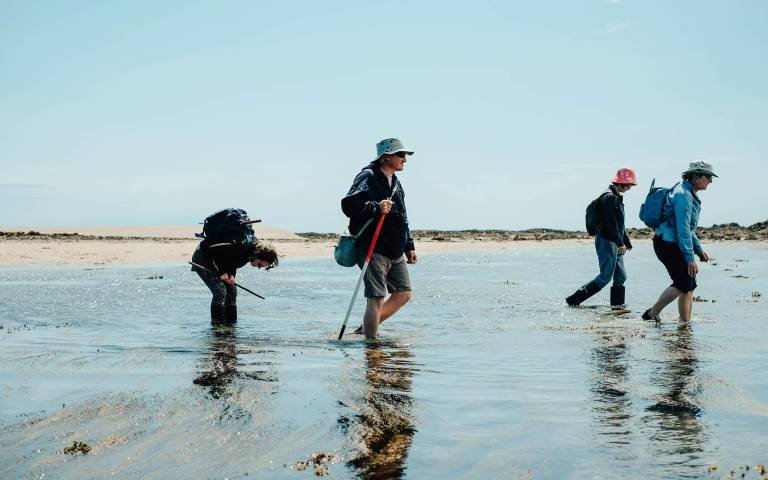A team of archaeologists, led by Dr. Matthew Pope from University College London (UCL) discovered spear tips and other stone tools that had been submerged under the waters of the English Channel since the last ice age. These artifacts offer a glimpse into a hidden landscape beneath the English Channel and provide insight into the activities of Neanderthal populations tens of thousands of years ago.

This expedition, part of a project funded by the British Academy and Leverhulme Foundation, allowed researchers to explore the exposed seabed for stone tools left behind by these ancient people. To maximize their limited window of opportunity during low tides, the archaeologists established their base of operations in a remote 18th-century stone tower located over a mile off the coast of Jersey.
At various times throughout prehistoric epochs, the landscape beneath the English Channel looked quite different from what we see today. During periods of intense glaciation, such as the last ice age, the sea levels were significantly lower, exposing land that is now underwater. The English Channel, which today acts as a natural barrier between Britain and continental Europe, was once a landscape inhabited by diverse animals and ancient human populations.
Dr. Pope noted, “At different times that landscape is going to be different. At some points, it’s going to be inundated by the sea, at other points it’s going to be on the edge of a vast landscape of river valleys and rocky outcrops, great places for hunting.” During the era when Neanderthals inhabited northern Europe, the region underwent dramatic climate fluctuations caused by various ice age cycles.

At the peak of these ice ages, the Arctic ice sheet extended far beyond its present boundaries, with sea levels much lower than they are today. During these periods, mammoths, bison, and other megafauna roamed the exposed lands beneath the English Channel.
To envision this ancient landscape, researchers analyze the current seabed and geological features, such as the island of Jersey, which was once a plateau rising above a terrain adorned with shrubs and grass, offering sustenance and navigable routes for the animals that traversed the area.
Dr. Pope and his team hypothesized that Neanderthals would have capitalized on the region’s intricate geography, using it for hunting and possibly ambushing game that followed the terrain’s natural pathways.
While they have uncovered butchered animal remains in nearby caves, it was uncertain whether the area around Jersey was indeed used as a hunting ground. Unfortunately, many of the stone artifacts that could reveal more about these ancient people’s behaviors remain submerged beneath the sea.
Dr. Pope explained, “Most of these rocky landscapes are too deeply submerged for us to carry out normal archaeology. We’d have to dive or use robotic submarines. It’s very difficult to find this kind of fragile evidence using those kinds of techniques.”
The discovery of a unique region called the Violet Bank off the Jersey coast presented an opportunity to explore the seafloor during low tides. The Violet Bank is a shallow granite reef that becomes visible during extremely low tides, allowing researchers to survey the area and search for prehistoric artifacts. Due to the limited window of time when the reef is exposed, the team had to be highly efficient in their exploration.
Jersey Heritage, a project partner, provided an isolated location for the researchers to stay during their expedition: Seymour Tower. This 18th-century tower was built as a coastal fortification to protect Jersey from potential French attacks. Positioned on a rocky outcrop more than a mile offshore from the Jersey coast, it becomes accessible during low tides.
Dr. Pope and his team carefully planned their expedition to coincide with the lowest and longest low tides, offering a brief period each day during which they could explore the temporarily dry landscape. This unique opportunity, although short-lived, allowed them to investigate the region, search for artifacts, and use drones to map the area.

The project also depended on local knowledge and safety precautions. Guide Nicky Mansell and the insights of local experts helped ensure the team’s safety and guided their artifact search. While some artifacts had been found by local individuals who were familiar with the landscape, this marked the first systematic search and recording of artifact positions by experts.
The team’s four-day expedition revealed several artifacts, including a significant Levallois point—a type of spearhead commonly used by Neanderthal people for hunting. These discoveries provided evidence of Neanderthal presence in the area and suggested the likelihood of more submerged artifacts.
Dr. Pope emphasized the significance of this pilot project and revealed plans for future expeditions aimed at uncovering more evidence of Neanderthal habitation. He stated, “This was a pilot project. We’re back to developing a longer-term project that can take advantage of low tides over three or four years to not only record that entire reef but also to make some initial inroads to some other reefs in the English Channel region.”
The discovery of these submerged Neanderthal artifacts opens a new window into understanding the lives and activities of our ancient human relatives in the distant past.


























